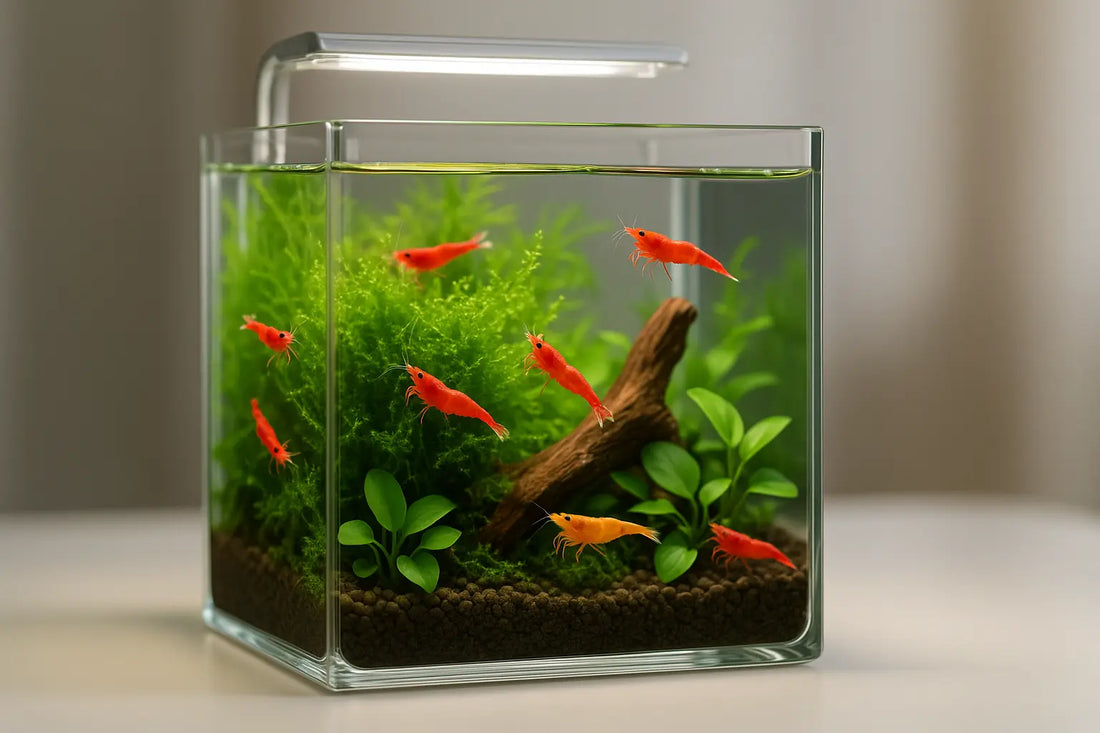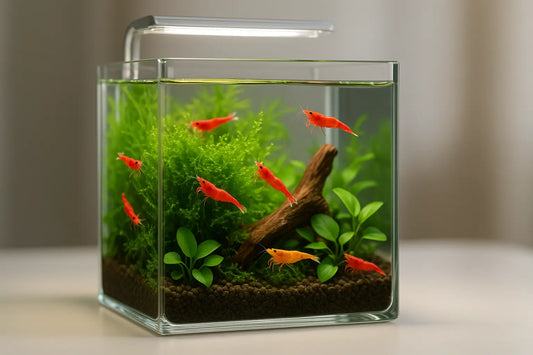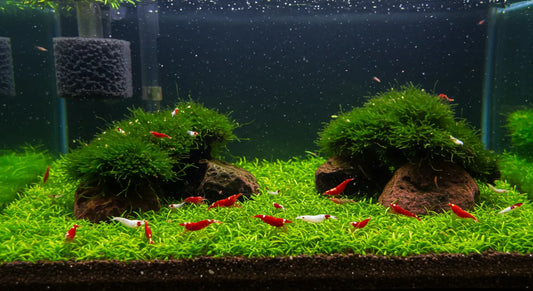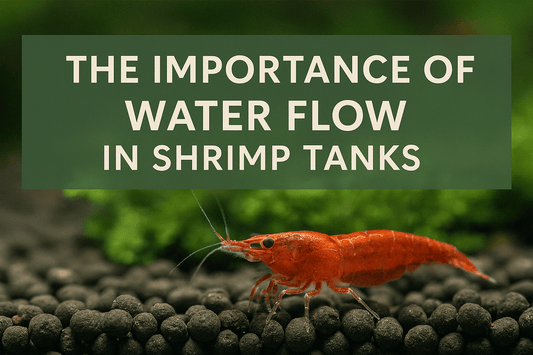
Setting Up Your First Nano Shrimp Tank: A Complete Guide to Small-Space Success
There's something magical about watching shrimp in a perfectly balanced nano tank. These tiny ecosystems pack all the wonder of a full-sized aquarium into a space that fits on your desk, nightstand, or kitchen counter. But here's the thing about nano tanks—their small size is both their biggest advantage and their greatest challenge.
I've set up a dozen nano shrimp tanks over the years, and I've learned that success comes down to understanding one crucial fact: in a small volume of water, everything happens faster. Temperature swings, water chemistry changes, and waste buildup all accelerate dramatically. But when you get it right, you'll have a thriving miniature world that's absolutely captivating.
Let me walk you through exactly how to set up a nano shrimp tank that will thrive for years, not crash in weeks.
Choosing Your Nano Tank: Size Really Does Matter
When people ask me about nano tanks, they usually want to go as small as possible. I get it—those 2-gallon cube tanks look adorable. But after watching too many beginners struggle with tiny volumes, I always recommend starting with at least 5 gallons, preferably 10.
Here's why: water chemistry stability. In a 2-gallon tank, adding just a tiny bit too much food can spike your ammonia dangerously high. In its early days, a dead leaf or small temperature change can crash the whole system. In a 5-10 gallon tank, you have much more buffer against these inevitable mistakes.
Tank Shape Considerations Cube tanks look fantastic and give you great aquascaping options with their equal dimensions. Long, shallow rectangles work well too and give you more horizontal swimming space. Avoid tall, narrow tanks—they're harder to light properly and it can be difficult to do maintenance on the bottom of the tank.
Placement Is Critical Keep your nano tank away from windows, heating vents, and air conditioners. The small water volume means temperature swings that wouldn't phase a larger tank can stress or kill shrimp in a nano setup. I learned this lesson when my first nano tank went from 75°F to 82°F in an afternoon because I placed it near a sunny window.
Foundation Elements: Substrate and Hardscape
The substrate choice follows the same rules as larger tanks, but it's even more critical to get it right since you can't easily change it later without restarting everything.
For Neocaridina Shrimp (Cherry, Blue Dream, etc.) Stick with inert substrates like fine aquarium sand or small gravel. These hardy shrimp prefer stable water chemistry, and nano tanks are challenging enough without adding the complexity of buffering substrates.
For Caridina Shrimp (Crystal Red, Bee Shrimp) If you're determined to keep Caridina in a nano tank, you'll need active soil to maintain the soft, acidic water they require. Just be aware that this makes an already challenging setup significantly more difficult. I'd honestly recommend starting with Neocaridina in your first nano tank. Use a buffering substrate like Brightwell.
Creating Visual Interest This is where nano tanks really shine. Small pieces of driftwood, a few carefully chosen rocks, or even a single stunning feature like lava rock can create incredible focal points. The key is proportion—what looks tiny in a 40-gallon tank becomes a perfect centerpiece in a 5-gallon nano.
I'm particularly fond of using small pieces of cholla or drift wood in nano setups. They develop beautiful biofilm that shrimp absolutely love grazing on, plus they add interesting texture without overwhelming the small space.
Filtration: Gentle but Effective
Filtration in nano shrimp tanks requires a delicate balance. You need enough flow to maintain water quality, but not so much that you create a hurricane for your tiny inhabitants.
Why Sponge Filters Are Perfect for Nano Shrimp Tanks After trying various filtration methods, I keep coming back to sponge filters for nano shrimp setups. The Qanvee Bio Sponge Filter QS100A has become my go-to choice for these tanks. If your tank is super small you may want to find a one barrel sponge filter.
Here's why sponge filters work so well: they provide gentle water movement that won't stress shrimp, offer tons of surface area for beneficial bacteria, and create zero risk of baby shrimp getting sucked in. Plus, the biofilm that develops on the sponge becomes an additional food source.
Avoid Common Filtration Mistakes Don't use hang-on-back filters without intake sponge guards—baby shrimp will get sucked up. Internal power filters often create too much flow for a nano tank. And whatever you do, don't think you can skip filtration entirely just because the tank is small.
Plant Selection for Nano Shrimp Tanks
Plants are super helpful in nano tanks. They help stabilize water chemistry, provide additional surface area for beneficial bacteria, and give shrimp places to hide and graze.
Low-Maintenance Champions Java moss is probably the most foolproof option—it grows in almost any conditions and provides excellent cover for baby shrimp. Anubias varieties stay small and attach easily to hardscape elements.
The Bucephalandra Advantage One plant that's become my absolute favorite for nano shrimp tanks is Bucephalandra sp. Centipede. These plants are perfect for nano setups because they stay relatively small, have incredibly unique leaf shapes that add visual interest, and develop fantastic biofilm on their surfaces.
What I love about Bucephalandra is that they're virtually indestructible once established, they don't require special lighting, and shrimp seem to spend hours grazing on them. The Centipede variety has these fascinating segmented leaves that look almost alien—perfect for creating a unique nano aquascape.
Plant Placement Strategy In nano tanks, every inch counts. Attach epiphyte plants like Anubias and Bucephalandra to your hardscape rather than planting them in substrate. This maximizes your floor space for shrimp activity while still providing plant benefits.
The Cycling Process in Nano Tanks
Cycling a nano tank follows the same basic principles as larger tanks, but with some important differences. For a complete guide to the cycling process, check out this article on how to cycle a Neocaridina shrimp tank, which covers all the details.
Key Nano Tank Cycling Considerations:
- Use less food during ghost feeding—a tiny pinch goes much further in a small volume
- Test water parameters more frequently since changes happen faster
- Be extra patient—rushing the process is even more dangerous in nano tanks
- Consider seeding with established filter media to speed things up safely
The cycling process typically takes 4-6 weeks, just like larger tanks. Don't be tempted to add shrimp early just because the tank looks ready.
Equipment Essentials for Nano Success
Heating Maintain steady temperatures between 72-78°F (22-25°C). Use an adjustable heater appropriately sized for your tank volume. In nano tanks, I prefer heaters with built-in thermostats to prevent overheating disasters. If your room stays
Lighting Moderate LED lighting works perfectly for both shrimp and most aquatic plants. Avoid intense lighting that can promote algae blooms in the nutrient-rich environment of a new nano tank. Many nano-specific LED lights come with dimming options, which is incredibly useful.
Testing Equipment Invest in a quality liquid test kit. In nano tanks, small changes in water chemistry can have big impacts, so accurate testing is crucial. Test weekly for ammonia, nitrite, nitrate, pH, and if keeping Caridina, GH and KH as well.
Stocking Your Nano Tank
Start Small I recommend starting with 8-12 shrimp in a 5-gallon tank, or 15-20 in a 10-gallon. This might seem conservative, but shrimp breed readily, and you'll have a full colony soon enough if conditions are right.
Species Selection Neocaridina varieties like cherry shrimp, blue dreams, or yellow goldenbacks are perfect for nano tanks. They're hardy, colorful, and forgiving of small mistakes. Save Caridina species for when you've mastered nano tank stability.
Acclimation is Critical Drip acclimate new shrimp slowly over 2-3 hours. The small water volume in nano tanks means even small parameter differences between your tank and the bag water can shock sensitive shrimp.
Tank Mates in Nano Setups
Less is definitely more in nano tanks. While you could add small fish like chili rasboras or otocinclus if your tank is over 5 gallons, I usually recommend keeping nano tanks shrimp-only, especially for beginners.
If you do want tank mates, a few small snails can actually be beneficial. They help clean up excess food and don't add much to the bioload. Just avoid anything that might view baby shrimp as snacks.
Maintenance: Small Tank, Big Attention
Nano tanks require more frequent attention than larger systems, but the actual work is minimal due to their size.
Water Changes Perform 20% water changes every other week, but make them smaller and more frequent if needed. In a 5-gallon tank, that's only about a gallon of water. Always match temperature and use dechlorinated water.
Substrate Maintenance You can gently vacuum detritus from the substrate during water changes, but be careful not to disturb plant roots or stress shrimp. A small turkey baster works great for spot-cleaning in nano tanks.
Filter Care Once a month, rinse your sponge filter in old tank water during water changes to remove debris while preserving beneficial bacteria. Never rinse it in tap water.
Parameter Monitoring Test water weekly, or more often if you notice any changes in shrimp behavior. Healthy shrimp are active, colorful, and constantly grazing.
Feeding in Nano Tanks
Less is Always More Overfeeding is the fastest way to crash a nano tank. Shrimp primarily graze on biofilm and algae, so they need very little supplemental food. I feed my nano tanks every 2-3 days with just a tiny pinch of specialized shrimp food.
Natural Food Sources Encourage biofilm growth with botanicals like Indian almond leaves. They not only provide food but also release beneficial tannins. Blanched vegetables like zucchini or spinach can be offered occasionally, but remove any uneaten portions after a few hours.
For more detailed feeding guidance, this shrimp feeding guide covers everything you need to know about keeping your shrimp well-fed without overfeeding.
Troubleshooting Common Nano Tank Issues
Temperature Fluctuations This is the biggest killer of nano tank shrimp. Invest in a reliable heater and consider a small fan for summer cooling if your room gets warm.
Rapid Water Chemistry Changes Small water volumes amplify everything. Make changes gradually and always test before and after any adjustments.
Algae Blooms Usually caused by overfeeding or too much light. Reduce feeding, shorten photoperiod, and increase water change frequency temporarily.
Shrimp Deaths If you lose shrimp, test water immediately. In nano tanks, problems escalate quickly, but they can usually be corrected just as fast if caught early.
Equipment and Supplies Checklist
For a complete list of everything you'll need beyond what I've mentioned here, check out this guide on essential aquarium supplies for shrimp keepers. It covers all the basics plus some helpful extras that can make nano tank keeping easier.
You'll also want to review the best practices for setting up a shrimp aquarium for additional setup tips that apply to tanks of all sizes.
The Rewards of Nano Shrimp Keeping
When everything comes together in a nano shrimp tank, it's lovely. I find myself mesmerized watching shrimp pick through the substrate, tend to their young, and go about their daily routines in their perfectly scaled world.
The key to success is patience, attention to detail, and understanding that in nano tanks, small mistakes can have big consequences—but small efforts can also create extraordinary results.
Start with quality equipment like a good sponge filter and interesting plants like Bucephalandra, keep your bioload conservative, and maintain consistent water parameters. Before you know it, you'll have a thriving colony of shrimp in a beautiful miniature ecosystem that brings joy every time you look at it.
Remember, every expert nano tank keeper started exactly where you are now. Take your time, learn from any mistakes, and enjoy the process of creating something truly special in a small space.


